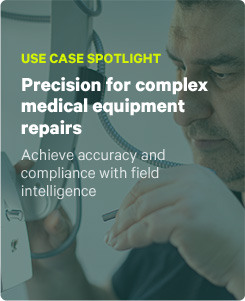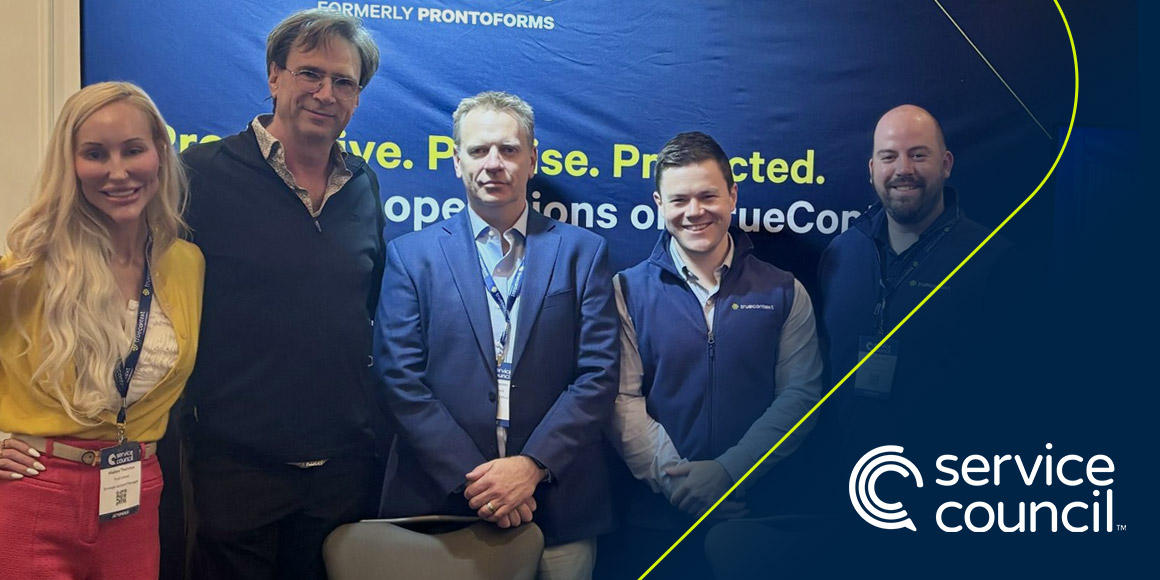Last month, TrueContext attended the Service Council Smarter Services™ Executive Symposium in Chicago. We have maintained presence at this event as a sponsor since 2019, and personally, it was my 3rd year attending. This year, over 250 executives came together from a variety of industries to discuss the latest findings of Service Council’s research, the macroeconomic challenges impacting their organizations, and to share how each is approaching them head on. With executives from leading service organizations like Philips, OTIS, Johnson Controls, and Becton Dickinson (to name a few), there were incredible insights, plans, and strategies to soak in.
The topic that permeated throughout every session was this year’s findings from Service Council’s Voice of the Field Service Engineer, which surveys thousands of technicians across industries. As the findings were central to so much of the conference, these insights are what I will be focusing on.
The productivity paradox in modern field service
This was my 3rd year attending the event, and for the third year in a row, Service Council research confirmed the same top three challenges for technicians:
- Time spent looking for information
- Paperwork and administrative tasks associated with service work
- Pressure to work faster or be more productive
We’re making headway; paperwork was #1 last year, but we’re still seeing these three major challenges rife across service. What I find interesting is the paradoxical relationship between these three points.
Technicians don’t feel that they have the right information at their fingertips to navigate the increasingly complex nature of their work. If the work depends on this information, they must find it, taking time to consult a variety of sources (service manuals, calls into support, or consultations with colleagues). On top of this gap, the methods they have to complete the necessary administrative work and data capture are typically outdated, performed through multiple systems or, dare I even say it, paper. Both issues highlight an all too common breakdown of processes in field service and go completely against the third challenge: pressures to be more productive. If your technicians can’t quickly find the information they require, when they require it, and the processes to document the work in the field is clunky and burdensome, they simply will not and cannot be as productive as you (and more importantly) your customer want them to be.
Throughout the conference, this theme was prevalent in presentations, breakout sessions, and discussions. So, what’s the solution? Here’s what leaders are focusing on to overcome this paradox.
Reducing the burden of administrative work
Admin work is a necessary part of field service. Someone must document the work that has been completed in the field, but the question is: can we do it better? Well, if we digitize the paperwork, then the problem is solved, right? Both in theory and in practice, it isn’t that simple. Yes, you will eventually need to ditch the paper to keep growing your productivity, but there is no magical solution that you can just plug into your field teams that will net them the productivity improvements you need. Often, this challenge is a symptom of greater organizational and even industry-wide challenges, and you must account for these realities. Here is how Service Council leaders are approaching the challenge:
- Understand the real process: Thekeyword is “real”. If you’re going to make the necessary improvements to reduce the burden of admin work, you must start with the people who are navigating the process today. Do you truly understand where they face delays, what sort of information they’re missing, and whether or not data capture is intuitive and appropriate? If you factor these into your planned solution, then you are on track for user adoption and acceptance, which often is the key driver of technological change.
- Include your citizen developers early: When talking about reducing burden, it’s important you don’t just shift the burden to someone else. If you deploy a new process solution that your technicians love, but it’s added much more work to the people who need to manage it in the office, then did you truly reduce the administrative burden? Involve these people early when evaluating process updates and solutions early, so they can understand what is needed to be done, and evaluate the solutions that not only help your people, but that are best for them to manage and iterate with. This ties back into balancing needs across all user personas present in your field operations.
- Define and plan for the data you need – today and tomorrow: You can easily boil down data into three categories: Need to have, nice to have, not required. Often, the “nice to have” and “not required” get lumped into the same category, but what happens when the nice to haves become a requirement? Needs are a sliding scale, and you’ll only need more and more data as your digital efforts become more robust and orchestrated.
In regulated industries like medical devices, energy, HVAC, and elevators and escalators, change is the single constant. If you’re constantly on the backfoot reacting to these changes, that will inevitably impact the people in the field, and you risk much more than a frustrated workforce – you open yourself up to compliance violations. Leading service organizations implement process updates to account for what they believe will become future requirements in a controlled and measured way. They seek to anticipate the future needs of regulatory bodies by working closely with them, staying informed through industry updates and conferences, and evaluating historical patterns. They account for the realities of their service teams (from office to field) and ensure that they’re involved in the development of these process updates. Lastly, they train their people on not just the “what and how”, but the “why”.
Bridging the information gap
You can have the most streamlined data collection and admin, but if your people cannot find the information they need, when they need it, then you’re not maximizing the productivity and efficiency of your staff. In the Voice of the Field Service Engineer survey, technicians listed the following areas of information that they are lacking today. I don’t know your service organization, but I’m willing to bet that you have all of these items in some shape or form.
- Spare parts visibility/inventory
- Service manuals
- Training videos
One of the top solutions to bridging this information gap is to phone a colleague. John Carroll, CEO of the Service Council, has broken down. If you have even a few technicians getting stuck once a day, and the average time to spend with a colleague on the phone is 15 minutes (which also bogs down another technician), you can extrapolate that over a year across your service organization and it becomes a massive cost to your productivity and bottom line. Essentially, every minute spent on calls is at least doubled when your technicians get on the phone with each other. So why are organizations still struggling to arm their technicians with this relevant and necessary that technicians themselves are saying they need? There’s no easy answer to that question, but here’s how the companies at Symposium are taking it on.
- Build the resources into the workflow: If you’re not finding a way to incorporate relevant resources into your service workflow when and where they need them (even offline) then you are behind. When a technician has determined that they are working on a particular asset, make it easy and obvious for them to find the relevant, most up-to-date service manual. If they input data that indicates there is equipment failure, incorporate information or documentation that defines relevant common issues and logical troubleshooting steps. This doesn’t need to be hard, and whether it’s with a tool like TrueContext or not, there are many ways to accomplish this.
- Implement feedback loops and act swiftly: The Voice of the Service Engineer is an incredible resource, but you can’t wait for its findings once a year to understand the areas you need to make changes. It’s an important benchmark, and you need your own data to compare against it. Sit down with your service managers or ideally, your technicians, and ask them: what are you missing? This doesn’t just go for resources – it can extend to your processes too. You must truly understand the needs of your people, and evaluate your in-house solutions. You then must challenge existing or prospective partners to help you meet those needs (more on that later.)
- Evaluating AI’s use cases: The AI age is here, and the capabilities to revolutionize your knowledge management efforts are robust. There are many immediate areas toward which you can begin building an AI strategy. Are you evaluating chatbots that will allow your technicians to reach out with their issues at any time in a service call, define what the problems are, and have potential next steps given to them that consider past service resolutions, asset and customer information, and existing SOPs? How about contextual knowledge delivery, so you can identify patterns to link historical service data to the issue at hand, along with courses of action that were taken in the past? There are several approaches to the same end, and many of your existing and prospective technology providers are already thinking about it and implementing AI capabilities into their solutions. Ask them how they’re doing this, and let them help you further build out your AI field service strategy.
As I’ve been thinking about the event and writing this, I’ve come to a conclusion: many of these insights feel obvious, and I think that’s the beauty of it. These service leaders are grounded. Sure, even they have their pie-in-the-sky wishes, and views on the far future of field service, but they are rooted firmly in the reality that they must grapple with today and the immediate future they must prepare for. Being grounded lets them be pragmatic in their approaches. They identify the need, they understand what courses of action they can take, and they action. In a way, they are very similar to the technicians that they represent. But there is one way they really stay ahead when they’re evaluating the best courses of actions to take: they challenge their solution providers.
Make us work for you. Challenge your prospective – and especially your existing – solution providers to demonstrate how they make both the field and the office more productive. Understand their vision for their solution, and how it will fit into your planned strategy and systems and address current and emerging field service trends. Better yet, partner with them to help you refine that strategy with capabilities you may have not thought of or best practices they see from yours and other industries. If you’re evaluating a solution and they can’t adequately address your challenges today and help you plan for tomorrow, even if it’s the cheapest alternative that solves your immediate needs, move on. Fast.




